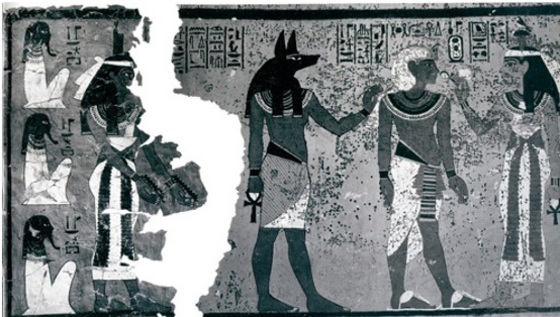
The view from the East wall looking West. Jaromir Malek’s text about the removal of the south wall can be seen on the left. © Ferdinand Saumarez Smith | Factum Foundation

A reflection of the video showing high-resolution information of each of the walls is reflected in the plan of the damage on the North Wall. A detailed observational survey of the entire tomb was carried out by Anna Paola Ferrara using the photographic data recorded in the tomb in 2009. © Ferdinand Saumarez Smith | Factum Foundation

The 58inch LED screen on the end wall of the annex with a text by Adam Lowe about Material Fragility on the left (with some details of some of the problems inherent in the paint surface) and the map of damage on the North wall on the right © Ferdinand Saumarez Smith | Factum Foundation

Pictures of the recording process and the damage recorded in the tomb © Ferdinand Saumarez Smith | Factum Foundation

The view of the facsimile of the missing fragment made from one of Harry Butron’s photographs now in the Griffith Institute. This section of the South wall was removed by Howard Carter in order to take out the objects. It was carefully preserved and stored for many years in the Treasury – its current whereabouts is unknown © Ferdinand Saumarez Smith | Factum Foundation

The entrance to the facsimile of the Burial Chamber from the Tomb of Tutankhamun. The facsimile is an exact replica of the the burial chamber as it was in June 2009 when it was recorded. The rest of the space is exactly the same size and layout as the original tomb but it is set out as an exhibition to explain why the tomb looks as it does and communicate the problems of preserving a site that was built to last for eternity but never to be visited. © Ferdinand Saumarez Smith | Factum Foundation

The display contains text by Jaromir Malek Nicholas Reeves, and Adam Lowe. The photographs by Harry Burton that were printed by Rafa Rachewsky at Factum Arte from files provided by The Griffith Institute, Oxford. The design of the display was done by Blanca Nieto. © Ferdinand Saumarez Smith | Factum Foundation

The walls are made from limestone blocks chipped by hand by Ahmed and Mohamed. The floor is made by the same craftsmen who made the wooden floor in the original tomb. The metal work and doors are also by the craftsmen who work in the Valley of the Kings. © Ferdinand Saumarez Smith | Factum Foundation

The lighting in the facsimile is with cold neon lights, similar to that used in the original tomb. The lighting in the rest of the display is with warmer LED lights. © Ferdinand Saumarez Smith | Factum Foundation

A view from the North West corner of the tomb looking towards the exhibition area. The gated door to the treasury can be seen on the left behind the lid of the Sarcophagus that lies on the floor. Due to the conservation work in the original tomb the floor is currently covered with wood and the lid is not currently visible. © Ferdinand Saumarez Smith | Factum Foundation

The view from the facsimile into the antechamber housing the images from the Griffith Institute and the text by Jaromir Malek and Nicholas Reeves. © Ferdinand Saumarez Smith | Factum Foundation
Reconstructing a fragment of the lost South Wall
A section of the South wall of the tomb of Tutankhamun was removed to access the tomb during its discovery by Howard Carter in 1922. The whereabouts of this section are currently unknown but Harry Burton’s black and white photographs of the tomb show this section of the South wall. In 2011, in collaboration with the Griffith Institute in Oxford, Burton's pictures were used to reconstruct a full-colour replica of the missing fragment. The colours of the figure of Isis were determined by studying the goddess's iconography. The three gods on the left side of the panel are unknown and were left in monochrome.

Digital reconstruction of a fragment from the South Wall © Factum Foundation








